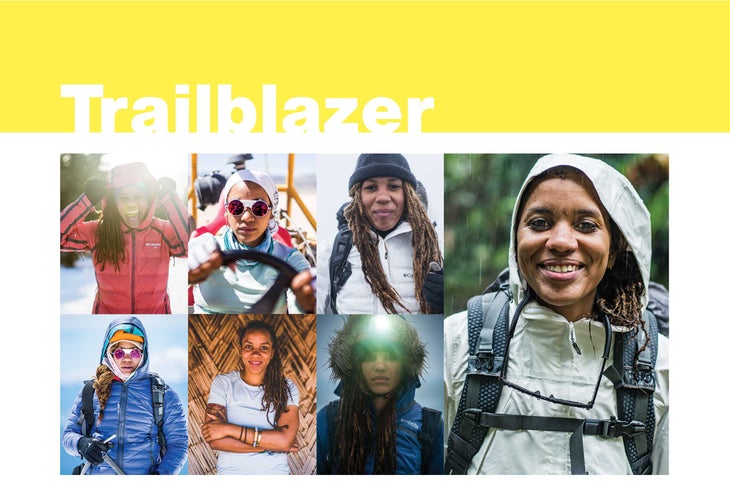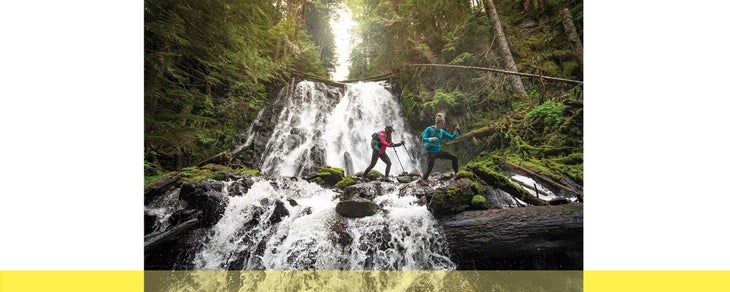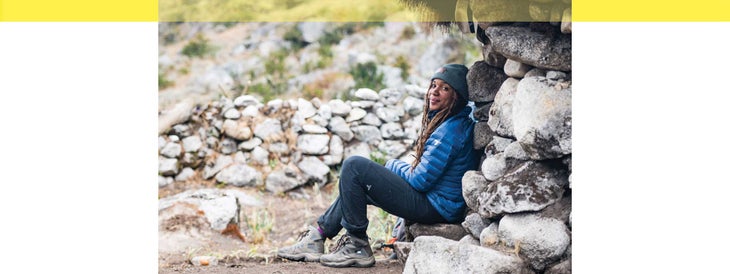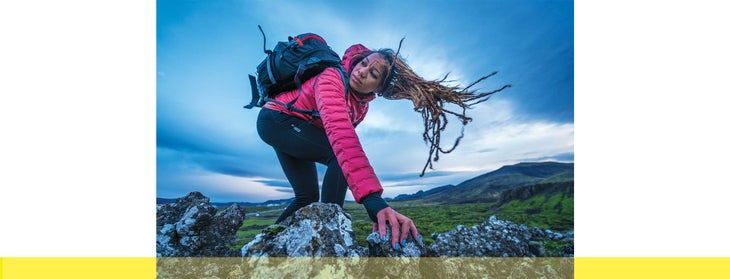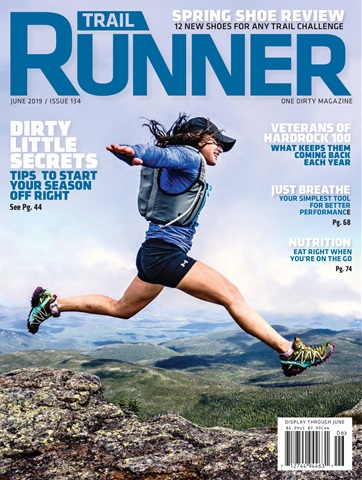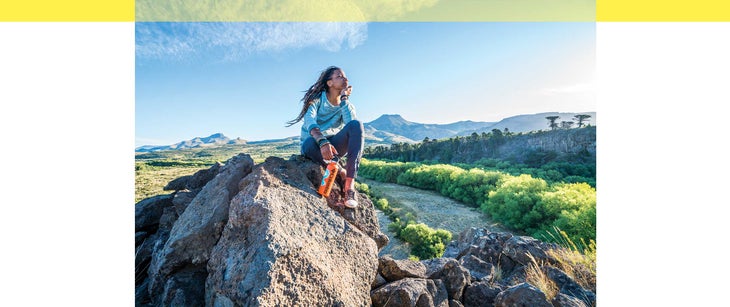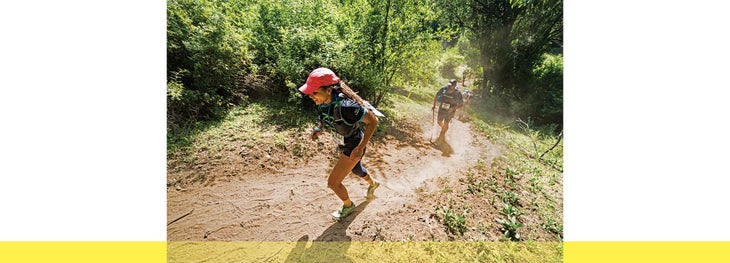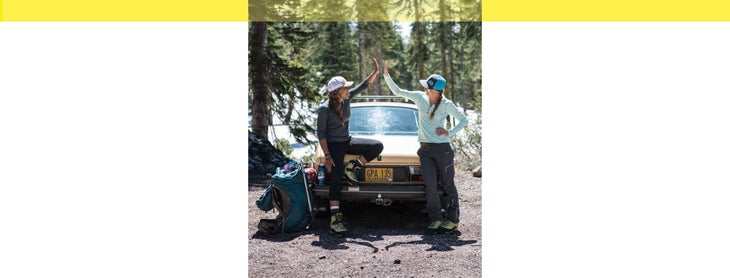New perk! Get after it with local recommendations just for you. Discover nearby events, routes out your door, and hidden gems when you sign up for the Local Running Drop.
Faith E. Briggs has a new running goal. She’s not going for a personal best, or an FKT. Briggs wants to have a conversation. It won’t be your typical chat over a cup of coffee. Briggs’ goal is to have a conversation over 240 trail miles, in six different national monuments across the country.
With her own two feet, a camera and a group of friends, Briggs intends to amplify voices that might otherwise not be heard and expand the discourse about public lands in the United States: what they are, why they’re important and who is welcome to them.
A documentary filmmaker with a focus on underrepresented communities, she plans to talk with runners and recreationalists of all backgrounds as well as folks who wouldn’t call themselves “outdoorsy,” to offer new perspectives on the unspoken ways people feel discouraged from entering wild spaces.
Briggs wants to talk about protecting the land while also welcoming everyone into it. To her, the two are inextricably linked.
“It’s becoming clear to me,” Briggs explains, “that we can’t actually responsibly protect public lands in this country if we’re not including all the voices in the conversation.”
Under Threat
Briggs, 30, originally from the Hudson River Valley in New York, is one of a few trail runners making this conversation a priority. Because of her films and her popularity on social media, she’s become a go-to source for diversity and the outdoors. She’s been interviewed by Men’s Journal, Melanin Base Camp (an online publication highlighting diversity in outdoor-adventure sports) and news sources local to her current home in Portland, Oregon, like the Get After It PDX podcast.
In Men’s Journal, she said, “I think a lot about the context of being outside, the kind of language that is inviting, and the barriers to entry for different people … People are realizing that it will take all of our voices to protect these places and with that comes the question: Why haven’t certain voices been heard before? The answer is they’ve been here, but their stories haven’t been told.”
In December 2017, President Trump decreased the size of two national monuments in Utah: Bears Ears and Grand Staircase-Escalante. Many felt that the voices of advocates, particularly native people who live on or near the land, had been ignored.
Trump’s actions came after a review by former Interior Secretary Ryan Zinke. Zinke’s review went beyond Utah though. It covered 27 national monuments and recommended shrinking or reducing restrictions on land use in several of those, including Oregon’s Cascade-Siskiyou, Utah’s Grand Staircase-Escalante and New Mexico’s Organ Mountains-Desert Peaks, all of which Briggs plans to run. Since then, Trump hasn’t made any moves to shrink these monuments—in fact, on March 12, 2019, he signed a bipartisan bill creating five new national monuments and expanding national parks. But Zinke’s review remains in place, and it troubles advocates, environmentalists and House Democrats who claim that shrinking the monuments is illegal. The House Natural Resources Committee hosted a hearing on the review on March 13th, but as of publication it remains in place.
“We have no idea what Trump is going to do next and looking at the next Secretary of the Interior, it doesn’t seem like championing public lands will be his first move,” says Briggs. “I would love to be surprised, but we’re in no place to get comfortable about land protections. Continuing to raise awareness and inviting more people to be advocates for land protections and to get involved locally and nationally remains a top priority.”
I was eating ibuprofen, lying in my trainers, saying things didn’t hurt and barely being able to practice. Nobody knew what was up.
The Evolution of a Trail Advocate
Briggs is defined by a mix of compassion and drive. Her frequent laugh is both gravelly and light and her voice rises with excitement when she talks about running, poetry, family, social issues, tacos, the squad that hits the trails with her … the list goes on. She is the type of person who picks up a phone call from a stranger like she’s greeting an old friend.
Briggs is biracial (her dad is black and her mom is white) and she grew up having conversations about race and privilege from a young age.
“My mom was disowned by her family when she chose to marry my dad,” she says. “It’s all good now, but I grew up in a house that was extremely conscious about identity and race relations.”
Her parents strive to engage with people about race with patience and compassion, even people they disagree with. Briggs grew up watching them change people’s hearts and minds with compassion rather than force.
“I believe that people walk around carrying a lot that we don’t see,” she says, “so language is a really great way to bridge that and I grew up seeing my parents do that.”
Briggs has carried that forward, according to her father, Paul Briggs. “Being from a mixed-heritage family allows Faith to be able to move compassionately through the world.”
“Do you know the saying: Come as you are?” says an old running partner, Huyen Nguyen, of Briggs. “She’s just so relaxed and non-judgmental and just very inviting, very welcoming, very open, very loving and very passionate.”
Naturally buoyant, Briggs sees running as an outlet for her intensity and passion. Her enthusiasm and kindness make her a natural fit in the outdoor community. However, the narrative of the “outdoors” and who belongs in it has always been troubling for her. Even though she’s loved being in nature ever since she was a kid, she would never have described herself as “outdoorsy.”
“No one ever called it that,” she says. “It was just called playing outside.” She didn’t have the money to travel to natural parks on vacation as a kid and didn’t run trails when she trained in high school and college.
She grew up running track in New York, trained by her dad from a young age. For a long time, the thought of a 240-mile adventure—or even a two-mile one—would’ve made her cringe.
“I was a sprinter, mainly a 400 runner—like, would not run an 800,” Briggs says, laughing. “Definitely a sprinter.” Her father was a 400-meter runner as well—he and his brothers set records in high school in events from the 4 x 400 to the discus, some of which remain today.
Briggs followed in her father’s footsteps and dominated the track in high school, making the varsity team her freshman year and winning the New England Prep School Track Association (NEPSTA) championships in the 400 and 200 her senior year.
After high school Briggs ran at Yale from 2006 to 2010 where she double majored in African-American Studies and Film, with a concentration on representation in media and documentary film.
“I’m always going to be interested in representation, regardless of the space where I’m working,” Briggs says of her major. “In any area I find myself, I’m going to be thinking about and researching representation and trying to understand why diversity related to race, gender, religion or socioeconomic background does or does not exist there.”
She became the track captain, made the All-Time list for the indoor 400-meter dash (57.80 seconds) and was part of a 4-x-400-meter relay team that set a school record (3:48:92). She was so driven that she attempted to train through six different stress fractures in her last years of college.
“By the end, I was eating ibuprofen, lying to my trainers, saying things didn’t hurt and barely being able to practice,” says Briggs. “I wanted to be able to compete, but I couldn’t even really do the training at that point. Nobody knew what was up.”
“When she started having trouble with her shins, I thought maybe she would stop running,” her father says, “but, you know, I guess I forgot how tenacious she is.”
Her tenacity took her from her double major at Yale to the University of Southern California, then to New York University for a Masters in Documentary Journalism, then to work as a writer’s assistant to author James McBride (African-American author of The New York Times bestseller The Color of Water and 2013 National Book Award recipient). During this time, Briggs was finally able to let her injuries heal, and, after a few years swimming and sporadically doing track workouts, she was ready to start running again.
She was going to grad school in Brooklyn when she started reading Born to Run and bought herself a pair of Vibram FiveFingers.
“I was so embarrassed about them—I would ride my bike or take the train to Prospect Park and then take them out and put them on and run … maybe a mile.” Slowly, she began to build up her base. Progress took time, but she was determined.
In New York, a lot of people don’t have a running background and run anyway.
After a few years developing her distance legs, Briggs joined Black Roses NYC, a crew of long-distance runners focused on marathons and speed. While the Roses focused on being fast and competitive, they were inclusive, an important trait for Briggs.
“In New York, a lot of people don’t have a running background and run anyway, and that was really cool,” Briggs says of the people she met in the Black Roses.
Briggs loved dodging traffic and darting down streets in the busyness that defines New York City. However, once she became acquainted with singletrack during a Black Roses event in June of 2016, she was changed.
That summer, she applied for, and was accepted to, the National Park Foundation’s (NPF) “Find Your Park Expedition” program. After hearing about it through a friend who had done it a year before, she jumped at the chance to see the country in a new way.
The Invitation to the Trails
“I didn’t really know anything about the National Parks,” Briggs says. “Yosemite and Yellowstone and the Grand Canyon; these are the things you hear about in history class, but they never seemed like anywhere I would ever go, could ever go. I think growing up the way I did, between cities with a family that was very blessed but didn’t have much money, I didn’t really think I could travel like that.”
She was one of a group of eight people chosen by the NPS to, as it says on their website, “show people everywhere what it’s like to explore a variety of national parks,” via their social-media channels and blogs. It was in Yosemite where Briggs, never one to miss a chance to run, started running trails regularly.
“Yosemite is breathtaking. You’re ripping down trails and coming around corners and you just get gobsmacked by these incredible vistas,” she says. “Every corner feels like you’re in a painting. I loved everything about it: the big sky, the waterfalls, the smell of a fresh prescribed burn in the valley.”
A few months later, having caught the bug to explore wild places, she applied to become a “Director of Toughness” with Columbia Sportswear. She was hired to essentially travel the world testing gear and making films about it. She moved to Portland, Oregon, to work with Columbia, establishing her place amongst the trails.
Playing outside with other kids at summer camp, then running in NYC, my world was not as homogenous as it is now in the spaces that I navigate.
Says Briggs of Portland, “There are so many trails that you’re going to hit one at some point. I think Portland really just encourages people to pop off the roads.”
It was during this time as a Director of Toughness that Briggs began to explore cultural representation in the outdoor community. “I first read Carolyn Finney’s work [author of Black Faces, White Spaces: Reimagining the Relationship of African Americans to the Great Outdoors] in 2016, because I was trying to better understand and contextualize the homogeneity that I was experiencing,” Briggs says. “Growing up and playing outside with other kids at summer camp, then running in NYC, my world was not as homogenous as it is now in the spaces that I navigate. That pushed me to search for explanations.”
In 2017, Columbia asked her to run El Cruce in Argentina, a three-day, 100-kilometer stage race with only about a month to prepare. Her eagerness once again got the best of her before El Cruce, and she over-trained her way to an injury. On the first day of the race she was limping and crying so much people were recognizing her at the end of the day as “the limping woman.” She’s captured on film, at the end of the first day, in pain and choking up: “I really love running … to have a day where I can’t do it in the way that I want to is hard.”
Later, Briggs says she called her dad in tears, and he gave her the perspective she needed to keep going. He reminded her of the slower athletes she had trained with in high school, who worked hard without ever making the podium and cheered for her victories as if they’d won themselves. “What is it that drives them?” Briggs’ dad asked her. “Find out what it is that is motivating those kids, and then you’ll know what it really means to be an athlete.”
Briggs holds onto this advice. “Running is about so many different things, and trail running for me has been very humbling,” she says.
After El Cruce, Briggs signed up for the 55-kilometer OCC at the Ultra-Trail du Mont-Blanc in Chamonix, France, one of the most coveted mountain ultramarathons in the world. It was on the trails of Chamonix, in a deluge of freezing rain, high fiving local school children and hearing the bells on decorated cows that Briggs started to feel she belonged in this community.
“I realized the camaraderie of ultrarunning,” she says. “Running into Chamonix, hearing the crowd cheering and banging on signs, it’s amazing. I think it’s the first time I understood what it meant just to be there, to be a trail runner, to be a part of this incredible little community.”
Now she’s pushing to invite more people in. She writes in the mission statement for her running project, “I now know I have an invitation to be in these places, places often widely untraveled by people from historically marginalized communities … I want people from urban communities, women who don’t call themselves ‘outdoor women,’ runners who aren’t typically on trail, people who don’t feel connected to the lands beneath their feet, indigenous folks and Latinx [gender-neutral term for people of Latin descent] recreationalists to be given an opportunity to fall in love with these places and to show the world they already have.
We’re out here, we’ve been here, we will be here, and our voices need to be heard.”
This Land was Made for You and Me
On one of the few trail runs Briggs did with the Roses, she summited a mountain. “It was crazy to me” she says. “I was looking down from the top of this mountain at the place where people took pictures for prom. I had hiked those trails and never even thought to run them, even though I’ve always been a runner. There’s just a mental barrier to trying a new activity when you don’t know anyone that does it.”
That mental barrier can carry over into entire communities. “I definitely don’t see many other women of color out on the trail running when I’m there. And I’ve been to races and trail series and not seen any; I’ve been the only one.”
There are reasons why trail running hasn’t yet been integrated into certain communities in the first place, she explains. A lot of reasons.
“That’s like an essay—or that’s not an essay, that’s a PhD,” Briggs says. “And there are people out there doing that work, for sure.” She cites Carolyn Finney again, as just one important example.
While she hasn’t done a thesis on the topic, she agreed to give a highly abridged explanation for this trend in the black community, based on her work, conversations and experiences.
First, there are historical reasons. “If you come from a place where people in your family worked the land previously, whether as slaves or as sharecroppers, or currently and historically as migrant workers, you might not be from a home that’s saying, ‘Oh we should go on a hike,’” Briggs says. Plus national parks weren’t exempt from the nation’s history of segregation—most had segregated facilities, and some, like Shenandoah National Park in Virginia, excluded black recreationalists entirely from the nicest areas of the park until the 1950s. This history means black recreationalists’ experiences with the land, and their feeling of safety within it, may be different.
Briggs brings up The Negro Motorist Green Book. “It’s basically what told people of color how they could travel safely in the 1940s and ’50s—where they could stay, where they were allowed to eat, things like that,” she says. “So there are a lot of reasons why, historically, black people specifically weren’t moving alone through spaces.” Of course, moving alone through spaces is exactly what trail running often requires and why so many are drawn to the sport.
Then there are the social barriers that have already been discussed—doing something otherwise unfamiliar to your community is hard. Mountain runner Joe Gray, who was the first black American to win the World Mountain Running Championships, thinks trail running feels inaccessible to black communities in part because of media and advertising. He argues that major media outlets for the sport don’t focus on black culture and brands don’t target black audiences in their advertisements.
Says Gray, 35, of Colorado Springs, Colorado, “You have very few black athletes in trail and mountain-running races, mostly due to the fact that it’s not marketed to that population.”
He also says that even when brands do sponsor black trail runners, the support may not be equal to other athletes. “I know some athletes who have some form of sponsorship but it’s not money, like other athletes that are doing very similar things.” That is, if a black runner is performing at the same level as a peer, the black runner may be less likely to get monetary support from brands.
Media representation also seems disproportionate to him—runners of color don’t get as much promotion. “And that is important in terms of creating inclusion in the sport, creating new fans,” Gray says. “They get to see someone who looks like them; I mean that’s kind of a big deal. You look at mountain-running teams and things like that—there’s almost no black people. I was the first black person to make the world mountain-running team for the U.S. I’m making history of that nature in the 21st century; that’s crazy.”
Many Monuments, One Push
These are the kinds of realities Briggs wants to talk about while she’s running the monuments with her friends or meeting the communities near them.
It was actually Briggs’ friend Addie Thompson who originally proposed the project idea. Thompson, 28, an ultrarunner who is currently getting her master’s degree in Public Policy from Columbia University, met Briggs a few years ago in Portland.
“We can be together for days and we don’t stop talking,” Thompson says, laughing.
Thompson ran 40 miles through Bears Ears in 2017 and was struck by the experience of connecting to the land. “I came back from that like, ‘Oh, my God, we’ve got to do something,’” Thompson says. She wrote up a plan to run six national monuments under threat in one push and sent it two places: the Obama Foundation and Faith Briggs. She never heard back from the Obama Foundation, but she heard right back from Briggs. She was on board immediately.
We will take a camera and a couple GoPros and run with our shoes and our packs.
Thompson reached out to Briggs because she didn’t just want to talk about conservation, but also, “how outdoor activity, and spending time outdoors, is inherently privileged for so many different reasons.”
It’s a conversation she and Briggs have a lot.
The goal of the project is to invite different people along to run different legs of the journey with Briggs. All of the runners have at least two things in common: they’re friends of Faith, and they’re members of groups—women, people of color or indigenous communities—that have struggled to have their voices heard in outdoor communities at one point or another.
“We’re not sponsored, we’re not elite, we’re not topping podiums at races … we wanted to represent a different community,” Thompson says. “The everyday person. The person this land belongs to.”
While the larger goal has always been to share their journey and conversation through film, the project doesn’t yet have sufficient funding. In fact, there’s a chance they’ll only be able to run three monuments, but they remain hopeful. Thompson says if push comes to shove, “We will take a camera and a couple GoPros and run with our shoes and our packs.” What matters most to them is recording the conversation about preserving the dirt beneath their feet and opening the space for women, indigenous people and people of color in the outdoors.
“Obviously we’re not going to be able to tackle all those issues, but I think even just starting the conversation has always been important to us,” Thompson says. “We don’t really know how to have [the conversation], but we know it has to be had.”
To Briggs and her crew, reaching out and asking questions of the communities they pass will be a way to achieve that. “I really want to be able to connect to people in each place—it’s their home,” Briggs says.
“I’m doing this all through running because that’s my medium,” she explains. “Language and running are the tools I have.” And while she’s a little nervous about being the through line for this project, she consoles herself with the thought of dialogue. “My goal is to provide a language toolkit to help us all have the conversation better and show why it’s important. That’s what this is all about.”
—Brooke Stephenson is a runner, writer and student at the College of William and Mary in Virginia.
